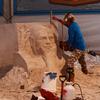Same boom, different year.
Downtown Denver’s decade-long economic explosion continued unabated in 2018 and the first part of 2019. More people are living in the city’s core neighborhoods than ever before. More people are working downtown than ever before. Heck, the 16th Street Mall even got that Target store economic development folks have been lusting after for decades.
On Thursday, the Downtown Denver Partnership held its annual State of Downtown Denver meeting where it highlighted its 2019 report on the status of what it calls the “center city.” Challenges remain — specifically when it comes to building a diverse workforce — but the report paints a picture of a downtown that is meeting the partnership’s goals of being economically healthy, vibrant and growing.
Here are some of the most eye-catching details covered in the State of Downtown report and at Thursday’s meeting:
26,000 people live in the downtown area
That’s a 13 percent increase over last year. And that’s just in the Central Business District, Lower Downtown, Auraria, Golden Triangle, Ballpark and Central Platte Valley areas, according to the partnership. Broaden the view to include Capitol Hill, Uptown, Five Points, Highland, Jefferson Park, Sun Valley and La Alma/Lincoln Park — the “center city” — and the population swells to about 89,000 people, a 10.5 percent increase over the past year.
RELATED: The Sweet Six: Downtown Denver’s standout projects completed in 2018
Population growth in those core neighborhood between 2010-18 was nearly double that of the city as a whole, according to data collected from Esri Demographics.
120 tech companies formed downtown last year
That brings the total number of tech businesses operating downtown to 724.
Growing the tech sector has been a major point of emphasis for the partnership the last eight to 10 years, Tami Door, the organization’s president and CEO, said during Thursday’s program. The efforts are bearing some high-profile fruit with companies such as Facebook and Amazon opening or preparing to open permanent offices downtown.
In total, tech employment downtown has grown 103 percent since 2010, according to the partnership. The 11,700 tech workers there now make up about 8.5 percent of the downtown area’s record high 138,970 jobs
Online study tool company Quizlet is among the Bay Area tech firms to recently open a hub in Denver. It’s based in a co-working space near Union Station with about a dozen employees for now. CEO Matthew Glotzbach said downtown emerged as the best place to locate because it appealed to the mostly young workers his company employs and had the best access to transit. He did spot an opportunity for improvement in the local market, though.
“The area I would highlight here is around diversity,” Glotzbach said. “As a small-but-growing company that serves a global universe of learners, we want to build a diverse team. It’s a key focus for us.”
For Quizlet, that means an equal representation of men and women in the workforce, people of color, especially in technical jobs, and people from the LGBTQ community.
Demographic data in the 2019 report shows that the downtown population has gotten slightly more diverse from a racial perspective in the last year. It is now 74 percent white. That figure was 76 percent last year. From a workforce perspective, Door pointed out after Thursday morning’s event that 70 percent of the core programs at the Commons on Champa — the 4-year-old business accelerator the partnership operates in partnership with the city — are focused on helping underserved communities including women, people of color and those from disadvantaged socioeconomic backgrounds.
$3 billion in projects
That’s the value of work recently completed, underway and planned downtown.
Related Articles
- May 16, 2018
Downtown Denver’s big boom continues, report shows people living in prosperous area overwhelmingly white, single and well off
- April 30, 2019
Amazon opening new office in downtown Denver to make room for 400 more workers
- February 18, 2019
Eyes on the Denver skyline: These sky-scraping projects stand to leave their mark on the Mile High City
To put a dollar figure on all the changes to downtown seen in 2018 or coming up in 2019, the partnership looked at 48 projects. Between them, they will bring a total of 3.5 million square feet of commercial space, 1,855 hotel rooms and 6,600 residential units to the city.
“This type of growth drives jobs and prosperity for all in our city,” Door said Thursday. “And, as we go forward, the economic impact will impact our city for generations to come.”


